Gas Foil Bearings for Micro-Turbomachinery
MAJOR APPLICATION: Oil-Free Turbomachinery, Micro-Turbines, etc
Sponsors: National Science Foundation (03-06), USAF Wright-Patterson
(04-05), Turbomachinery Research Consortium (04-08), Capstone Turbine
Corp. (07), NASA Glenn RC (07-09)
|
Technical presentation |
Slide show
(40 MB) |
|
Our work until
Dec 2010 |
Pdf file
(2 MB) |
|
|
Movie: test rig operation (8.8 MB) |
For more recent
work, please browse URL sites from foreign researchers, KIST for example
 Objectives:
Objectives:
To quantify the physical parameters of bump foil gas bearings for
micro turbine applications
To measure the rotordynamic response of a rotor supported on gas
foil bearings and to identify the bearings force coefficients
To develop computational models, benchmarked to test data, to
predict the forced performance of gas foil bearings
Status: Identification of foil bearing
structural stiffness and dry-friction (damping) parameter for increasing loads
and frequencies and shaft temperatures completed. Available operating test rig
with hollow rotor supported on gas foil bearings, top speed 50 krpm. The
computational analysis developed shows excellent correlation with published
load capacity data. The test rig will provide much needed information on
dynamic force coefficients.
PAST work: Rotordynamic Performance of Foil Gas
Bearings: Tests and Analysis
Research program, analytical and experimental, to advance the technology
(design and operation) of gas foil bearings for oil-free turbomachinery. The
major tasks are:
·
Comprehensive modeling of gas foil bearing performance
(static and dynamic) operating at high speeds with minute film gaps. The model
includes thermo-elastic deformations of the foil and elastic members (bump
strips), including hysteretic effects due to dry friction from coatings and
local contact zones.
·
Exhaustive (independent) experimentation of foil bearings in
a test rig for accurate determination of rotor lift and touch down speeds, load
capacity and drag power losses, and identification of rotordynamic force
coefficients.
The construction of a rotordynamic test rig for foil gas
bearings was completed in early 2004. A DC motor, with maximum speed of 50
krpm, drives a 2.2 lb hollow rotor supported on two foil gas bearings.
Presently, experiments to identify the rotor-bearing modal stiffness and
damping parameters are close to completion. The test rig incorporates an
electromagnet to apply non-contacting loads on the rotor. The proposed tasks are:
a)
To develop reliable methods for identification of stiffness
and equivalent (viscous) damping force coefficients in foil gas bearings.
b)
To conduct rotor imbalance response tests to extract the equivalent
stiffness and (viscous) damping coefficients of the test gas foil bearings.
c)
To correlate the experimentally identified FB force coefficients to
predictions derived from a parallel computational analysis effort.
Turbomachinery users and manufacturers will benefit from a planned
research effort to characterize foil bearings thus increasing their confidence
on the deployment of foil gas bearings in commercial products.
Predictive software
available for licensing, see GFBsoftware
To learn more,
order/read our PUBLICATIONS
TEST RIG FACILITIES
(Left) Generation II Gas foil bearings (Right) set up for shaker excitations


Rotordynamics test rig (Max. speed:
50 krpm)

STRUCTURAL STIFFNESS for TEST FOIL BEARING
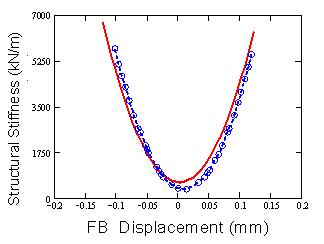
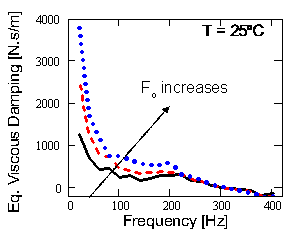
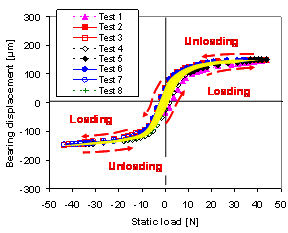
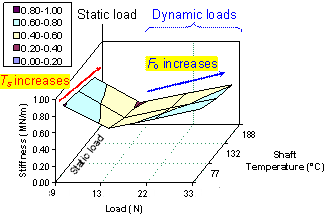
COMPUTATIONAL MODEL PREDICTIONS ANCHORED TO TEST
DATA
Minimum film thickness and journal
attitude angle (Test data from literature)
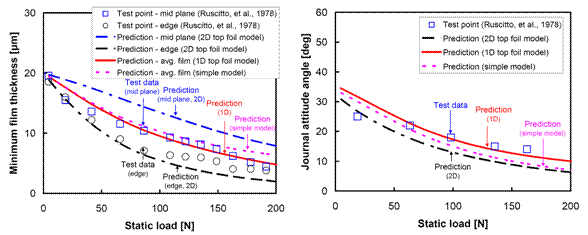
Torque and load capacity (Test data from literature)
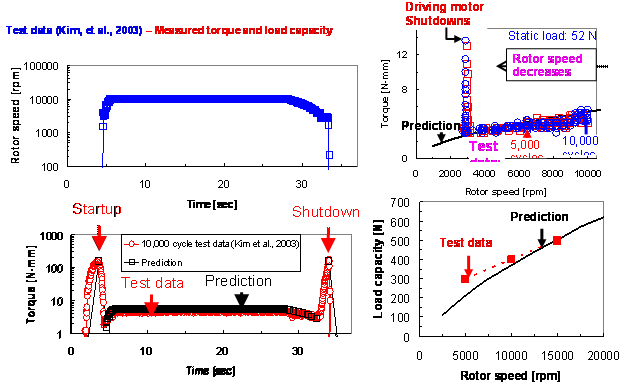
Rotor synchronous response and phase
angle, measurements vs. predictions
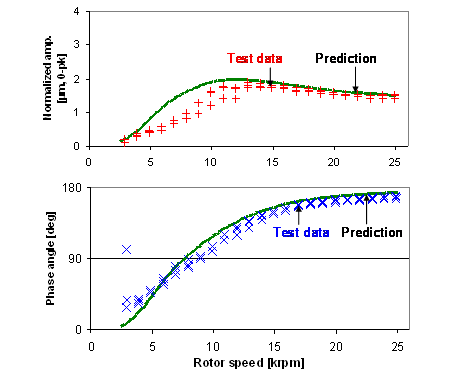
Non-synchronous
force coefficients (Test data from literature)
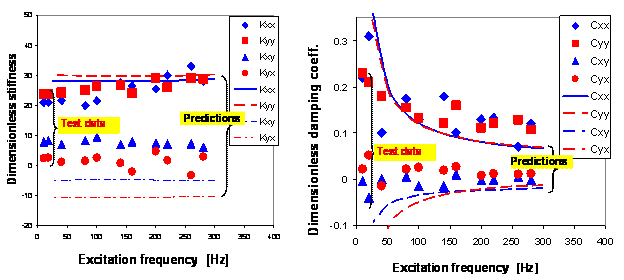
ROTORDYNAMIC PERFORMANCE
WITH SIDE PRESSURIZATION
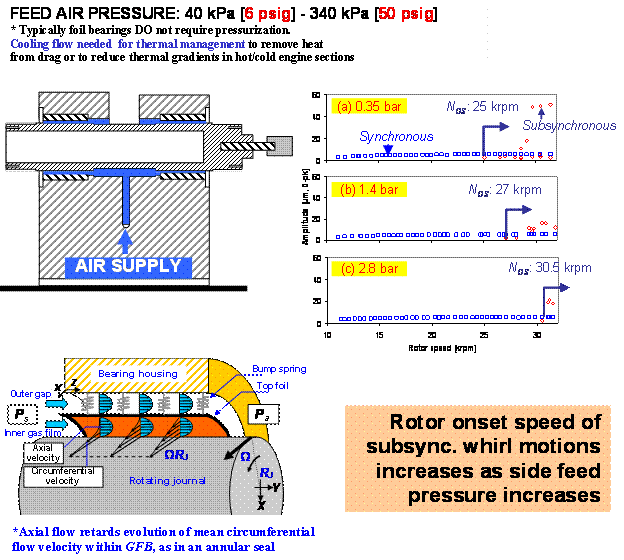
FORCED NONLINEAR ROTOR RESPONSES
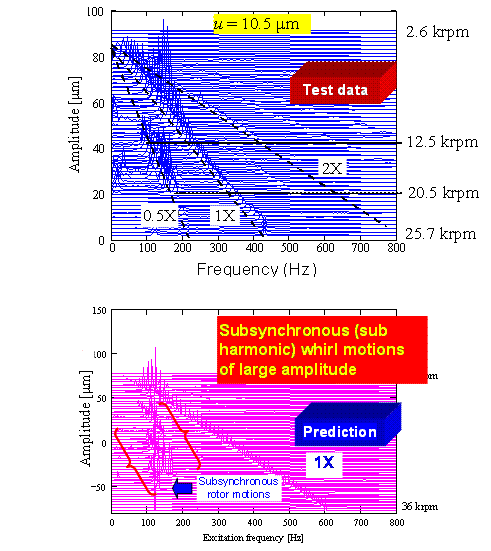
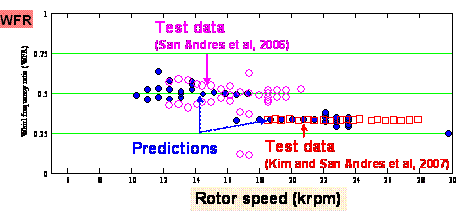
2003: Rotordynamic Performance of
Foil Gas Bearings: Tests and Analysis
TEST RIG FACILITY
(left)
rotordynamics test rig (right)
set up for shaker excitations
Measured STRUCTURAL
STIFFNESS for TEST FOIL BEARING

VIRTUAL TOUR – download Video clip of test rig (11 MByte)
COMPUTATIONAL MODEL
Comparisons
of journal attitude angle and minimum film thickness vs. load (Test data from
literature)

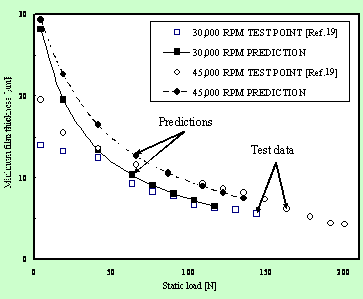
To learn more,
order/read our PUBLICATIONS